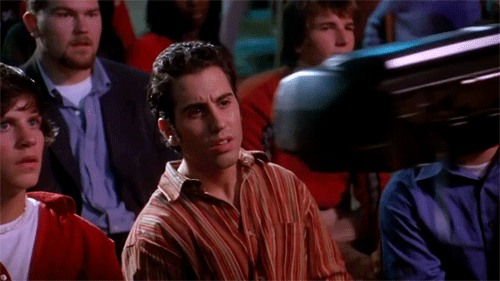
Un 20 de agosto de 1981 unos colegas venían de farra a bordo de un R12 por la avenida de Beiramar de Vigo. Querían seguir la juerga en un chiringuito de la playa pero una repentina niebla y unas inoportunas obras en la calzada se interpusieron en su camino. A bordo iban José Manuel Barros, Manolo Romón, Miguel Costas, Javier Soto y Alberto Torrado. Conduce Julián Hernández, que había robado el coche a su padre para esa noche. El golpe fue tal que la compañía de seguros declaró el vehículo «siniestro total». Acababa de nacer un mito. Afortunadamente, ellos vivieron para contarlo.
Julián Hernández (Madrid, 1960) llega puntual a nuestra cita en una cafetería de barrio próxima al Retiro madrileño. Es afable y cercano, constantemente hace referencias a otros autores, personajes y músicos, como si no quisiera darse excesiva importancia a sí mismo. Viste con colores apagados: americana y zapatos negros, camisa azul marino y vaqueros grises. Sus características gafas bajan a media altura de la nariz y provocan algunos quebraderos de cabeza a la fotógrafa. Pide una infusión con dos bolsitas y fuma tabaco de liar. Julián no solo es el líder de una de las bandas más representativas del rock patrio sino que además ha sido testigo de la ebullición de una época. Lo sigue siendo aunque las apariencias engañan. Detrás de esa imagen pública de gamberro irreverente se esconde una persona sencilla, mucho más poliédrica de lo que pudiera parecer, donde ingenio y sentido del humor se dan la mano. La (larga) conversación fluye natural, los temas van saliendo de manera espontánea, zigzagueante y un tanto desordenada. Aun así, muchas cosas se quedan en el tintero. A micro cerrado confiesa lo que muchos sospechábamos: la antológica frase «zumo de naranja en las tetas de la negra» de la no menos antológica «Cuánta puta y yo qué viejo» está basada en hechos reales, como el resto de la canción. «¿Pero se puede decir quién disfrutó de tan suculento manjar?». «Hombre, no sé si debería…».
Te voy a dar una buena noticia: hay rumores de que los Kinks van a volver.
Nunca he tenido la noción clara de que los Kinks se hubieran ido. Los discos de Ray Davies también me parecen discos de los Kinks. Lo que pasa es que… ¿quién lo escribía el otro día?… A los chavales ahora les gustan más los grupos que les gustaban a sus padres, o quizás a sus abuelos. No hay más que ver la revista Mojo, qué saca en las portadas…
Lo digo porque vosotros siempre habéis sido muy reivindicativos de la música de los Kinks, nunca has perdido ocasión de mencionarlos.
Hombre, es que los Kinks son palabras mayores…
Así que más que de Beatles-Stones tú serías de Who-Kinks.
Sí, sí, Who y Kinks. ¿Qué tonterías son esas? Los Beatles y los Rolling Stones… Bah. Es lo mismo que pasó después con lo de Oasis o Blur. Pues no, Pulp.
Igual que con los Kinks, ¿veremos algún día una reunión de los Torrados, Copinnis, Costas…?
Creo que no. Si lo hubiéramos dejado, igual sí. Si es por el lucro indecente de los Sex Pistols, no me parece mal… [Risas] Pero creo que ahora eso es imposible, el grupo está funcionando.
¿Cómo fue el proceso de asimilación de todas tus influencias? ¿A qué llegaste primero?
Lo primero eran las canciones de Andrés Do Barro, de pequeño. Y luego la primera noción clara que tengo de rock, y de una canción que me gustara, era de Suzi Quatro, Can the Can, aparte de que me sigue pareciendo una sex-symbol.
¿Qué tiene el blues? ¿Es como el origen de todo?
El blues… coño, es una escala de cinco notas, tres acordes y doce compases, no hay más. Y luego todo lo que escuchas… no hay un riff de AC/DC que no esté basado en eso. No creo que Public Enemy estén al margen de eso. Todo está alrededor de esa idea.
Me hace gracia lo de «gallego en el exilio». ¿Eres el madrileño más gallego de este país?
No, hombre, no, igual soy el gallego más madrileño [risas]. Yo nací en Madrid, pero de casualidad.
Esto de intelectual del rock que alguna vez se ha dicho de ti. ¿Halaga, molesta, abruma, te da igual?
En todo caso, me tiene sin cuidado… Pero, ¿cómo que intelectual? El rock and roll es una cosa primitiva, de cómo volver al Holoceno. Hay una cosa, si intentar huir de los tópicos del rock, tener un pie fuera y mirar lo que es el rock desde un punto de vista de «no me lo creo todo», no voy a vivir rápido, drogarme y dejar un cadáver bonito entonces, pues sería como lo de Frank Zappa o algo así… Tampoco nos planteamos nada.
Tu profesora de Ciencias Naturales del colegio te definió como «un chaval rubio, muy modoso y aplicado». Ya de pequeño apuntabas maneras.
Eso queda fatal para un músico de rock, ¿no? Joder, Marilar me va a destrozar la carrera… [risas].
¿Tenías enchufe porque tu madre era también profesora?
Todo lo contrario, mi madre era la profesora de Dibujo, todos los profesores me miraban con mala cara como diciendo «a este lo puteamos»… Hombre, no era un puteo, pero no era un favor, todo lo contrario.
¿Cómo era la educación de aquella época?
Estudié en el Colegio Alemán de Vigo, laico. No era un colegio caro, ni rollo de pijerío. Había gente de todo tipo. Lo que pasa es que eran alemanes, con todo lo bueno y todo lo malo. Alemanes de un lado y alemanes de otro. Había profesores que hablaban entre sí y otros que hablaban pero no se comunicaban entre ellos. El día que me quedé con la copla fue en una excursión. Nos llevaron a una playa en Vigo. Eran dos profesores, uno del sur y otro del norte, uno como bávaro y otro de Hamburgo. Muy diferentes, hablaban diferente. Pero de repente uno, que era el más atleta, empieza a dar unas zancadas enormes y se tira al mar. Estábamos jugando y pensamos «¿Este qué hace?». Se tira, «plas», sale del agua y a veinte metros de la orilla levanta el puño y le dice al otro «HO CHI MIN». Era plena guerra del Vietnam y dije yo «¿Estos de qué van?». Todos acojonados… [risas]. Lo recuerdo con cariño, pero entiendo que Alemania vivió una guerra civil permanente.

El día que muere Franco estabas tocando la primera guitarra eléctrica de tu vida. No hubo mucho duelo…
¿Cómo lo iba a haber? Nos dieron una semana libre y encima me llamó Torrado que su madre le había regalado una guitarra eléctrica. Bueno, pues que se muera todos los días… [risas], que resucite y se muera.
¿Habías entrado ya en el Conservatorio para estudiar guitarra clásica?
Creo que sí. Es lo único que se me ocurrió para aprender. Fue por un amigo del Colegio Alemán que estaba estudiando allí.
¿Acabaste la carrera de guitarra?
Sí, sí. Pero era muy malo, la hice a trancas y barrancas. El pobre José Luis Rodrigo, mi profesor, que además era muy bueno y un concertista de la hostia… Yo estaba ahí y había un montón de asignaturas: armonía, acústica… había que currárselo. También dejé Filología al segundo año.
¿Llegaste a ejercer?
Qué va. Vi el panorama que me tocaba de compañeros de claustro y empezaba a funcionar el grupo y decidí posponerlo. Hasta ahora.
En aquella época también eras asiduo de unas jam session de blues en El Manco de Vigo, donde tocabas el piano y cantabas. El Sexteto de Blues…
¡¡Es verdad!! ¿Ahí tocaba el piano? No sé por qué tocaba el piano, lo mamporreo, pero no sé tocar el piano… Fue una especie de mentira. Pusimos en un cartel una foto de unos negros en Maxwell Street y llegamos a tocar en el auditorio del Ayuntamiento…
¿Qué tenía Vigo? En general, me llaman la atención las ciudades portuarias, véase Barcelona, Gijón o Liverpool, Hamburgo…
… Seattle…
También… ¿Qué tienen esas ciudades portuarias que dan tan buenas escenas musicales?
No creo que lo de Vigo sea extrapolable, pero sí que habría que echarle un vistazo. Supongo que en las ciudades con puerto hay bares abiertos toda la noche, y eso crea una cierta relación entre músicos. En el caso de Vigo, hubo una escena increíble en los años sesenta que está prácticamente olvidada. Había un montón de pop, rock, grupos tocando canciones de los Beatles, de los Kinks… Pero no salió porque casi no grabaron nada… Hicieron una especie de reunión a finales de los setenta, fuimos al concierto. Y grabaron un disco que se llama Reencuentro, creo, horrible, una cosa nostálgica, pero de diez años antes. Se lo debían pasar en grande. Lo hacían para ver si follaban.
Te metiste en la música para follar, beber cervezas gratis y pasarlo bien, según has confesado en más de una ocasión.
Hombre, supongo que es lo que hace todo el mundo, ¿no? [risas] No es cierto, era porque nos gustaba…
Treinta y dos años después, ¿cómo es el balance en función de esos objetivos?
El balance es que es mucho mejor la música, porque no me queda otra cosa más que hacer… [risas].
Tuvisteis una polémica con Héroes del Silencio por ese tema…
Fue una declaración de Bunbury en Primera Línea o algo así: «Nosotros estamos en esto por la música; no como Siniestro Total, que están aquí para follar y son unos bandarras…». Y contestamos que los Héroes del Silencio era mejor que estuvieran callados. Entonces empezó una historia que a mí me hubiera encantado que hubiera llegado a ser gordísima, pero no lo conseguimos: ellos tenían mucho éxito y nosotros no. No era como Oasis y Blur. Luego hablándolo con Valdivia (guitarrista de Héroes) nos reíamos a carcajadas, teníamos que haberlo explotado.
Tu madre también pensaba que estabas en el grupo para pasarlo bien, ¿no?
No te lo pierdas, que el otro día, cuando sacamos esto de una sola canción en Internet y dijimos que lo que queremos es grabar canciones como si fueran singles, el maestro Manrique, Diego A. puso: «Van a sacar singles por capricho». Hombre, si sacar singles es por capricho, todo es por capricho.
Ahora que están de moda por enésima vez los Beatles, matáis al Sargento Pimienta…
Está bien porque ha coincidido con todos estos homenajes a los Beatles. Nos vamos a cargar a los Beatles. Pero vamos a ver… si uno de tus primeros éxitos dice «Voy a cogerte de la mano», I want to hold your hand, y luego hay unos tipos diciendo All day and all of the night, «Quiero pasar contigo todo el día y toda la noche…», o sea, FOLLAR… De cogerte de la mano a echar un casquete hay una diferencia… Ahí ganaban los Kinks. O el My generation.
Dejas Vigo en 1977 para venirte a Madrid, ¿cómo era el Madrid que te encuentras?
Muy triste. Se había muerto el Militar de Alta Graduación procedente del Noroeste dos años antes. Hombre, con 17 años no puedes hacer muchas canalladas. En el colegio mayor, en el Johnny, había conciertos y eso… Era triste por eso. Policía por todas partes y todo ese rollo… Aunque también empezaban ya por aquella época en colegios mayores grupos como Tequila, Cucharada, Burning, el rock… Yo corté entradas para Burning en el colegio mayor.
Según he leído, te impresionó ver a Manolo Tena tocando el bajo vestido de monja con Cucharada en los Capuchinos de Vigo.
¡Era genial! Dije «Hombre, yo me quiero dedicar a esto, pero si me tengo que vestir de monja…». Estaba bien porque había un momento del show, Irrevocablemente inadaptados, en el que salía un tío entre el público y mataba al cantante a tiros. Debía ser como los Kiss o algo así, una especie de teatro musical.
Estabas en Madrid, pero ibas a Vigo constantemente. ¿Por esa época nace Siniestro Total?
Habíamos empezado en el instituto a tocar todos juntos. Torrado y yo habíamos estado en el Colegio Alemán, luego nos separamos porque cada uno fue a un instituto. En el que yo estaba, en el Calvario, ya estaban Javier Soto y Miguel Costas. Siniestro llegó ya pasado el tiempo, en el 81. No era una cosa pretendida. Tocábamos en casa y no creíamos que nadie nos quisiera escuchar. De repente, estábamos tocando las canciones de todo Dios y pensamos «a lo mejor se puede hacer alguna propia, por rellenar un repertorio». Fue también un festival que había en Vigo que se llamaba Nadal Rock, que estaba Reixa metido en la organización y dijo «poneos un nombre». Nos habíamos pegado la hostia en el coche…
Nunca un accidente en un R12 fue tan trascendente para la historia del rock.
Objetivamente sí [risas]. Nos pusimos el nombre que dijo la compañía de seguros y tocamos allí. Tuvimos que hacer las canciones por teléfono porque yo estaba en Madrid. Llamaba a Miguel, Alberto tenía cosas, Coppini también tenía alguna letra y lo hicimos así.
Empezaste tocando la batería en el grupo.
La verdad es que… ¿Quién no quiere tocar la batería? ¿Quién no quiere ser Keith Moon? [risas].
Tu primera batería te la deja el propio Antón Reixa, ¿no?
Reixa nos dejó el garaje de su padre y tenía ahí la batería. Pensamos: «Lo tenemos todo, esto es un chollo». Fue un crack.
De hecho, él compuso uno de vuestros primeros hits: Más vale ser punkie que maricón de playa.
Sí, fue una frase de él y de Rubén Losada de Os Resentidos, y la montó Miguel. También otra sugerencia de Reixa fue Nocilla, ¡qué merendilla! Es que convivíamos. Yo grabé la primera maqueta de Os Resentidos en un cuatro pistas.
Luego fue presidente de la SGAE, menudo cambio…
Claro… es que dices «ah»…
¿Estás en la SGAE como autor?
¿Dónde íbamos a estar? Era una herencia de los monopolios y sigue siendo un monopolio, más o menos.
¿Qué le pasa a la SGAE? ¿Se la han cargado?
Hay cuestiones políticas muy gordas. Lo último que está pasando, y al hilo también de la canción ¿Casualidad? No lo creo, coincide que la SGAE entra dentro de unos procesos internos muy chungos justo en el momento que se está tramitando una Ley de la Propiedad Intelectual, que es muy interesante tramitarla sin que haya una agrupación de autores sólida que llegue y diga «esto no puede ser».
Entonces, ¿Reixa ha sido cabeza de turco?
Sí, hay muchas cosas, es tal el follón… Creo que Teddy Bautista hizo cosas muy buenas cuando llegó; limpió la historia, metió a la SGAE en la modernidad, pero no se puede estar tanto tiempo en un mismo puesto, las cosas se pueden ir de las manos. Teddy Bautista se quedó en esa idea de los ochenta, que estaba bien, pero llegó un momento en que no…
Desde luego la campaña de comunicación no ha sido muy buena, parece que la SGAE es la que roba.
Hasta límites delirantes, la gente odia más a la SGAE que a los bancos. La imagen ha sido horrible, y luego la gestión interna, lo de la pasta, ha sido la debacle, pero como todo en este país, rasca un poco en cualquier lado. Luego no han conseguido hacer entender a la gente eso que ponía en los vinilos de «prohibida la reproducción pública». Tú compras eso y lo reproduces para ti, si lo pones en otro lado y ganas dinero…
Ya, pero ¿cómo se hace entender eso en la era de Internet?
Ahora mismo la SGAE no tiene más opción que la competencia, y que se ponga las pilas todo el mundo. Luego también hay otra cosa: sin derechos de autor probablemente no se puedan generar contenidos nuevos. En la red es todo gratis, salvo lo nuevo. Hay muchísimas cosas, tienes todos los podcasts del mundo, puedes escuchar lo que quieras en YouTube.

Estuviste metido en el mundillo discográfico: en 1987 con Baterías Taponadas y en 2005 fundas Discos de Freno.
Era para sacar los discos de los amigos o nuestros, tanto lo de Baterías Taponadas como lo de Discos de Freno. Pero uno no vale para eso. La idea de una discográfica que tenga un criterio para sacar cosas es muy complicada si no tienes a nadie más. En el caso de Discos de Freno estaba Mario Pacheco echándonos una mano…
Una curiosidad: ¿cómo consigue uno librarse de la mili a los diez días?
Por pies cavos, se supone que unas botas militares me iban a hacer daño y no podría desfilar. ¡Yo, que he usado botas militares casi toda mi vida!
¿Qué tal fue la experiencia?
Si hubiera llegado a saber que eran diez días hubiera firmado con alegría, pero como no lo sabía, fueron horribles. Cuando me largaron pensé que a lo mejor no había estado tan mal.
¿Lo mejor que hizo Aznar fue suprimirla?
No, no es lo mejor. Yo ahí estoy con Sánchez Ferlosio, que escribió un artículo totalmente a contracorriente diciendo que era un error hacer un ejército profesional porque se desliga de la sociedad, en lo otro fluye gente que no tiene nada que ver con el ejército, con lo cual no hay una idea golpista, por ejemplo. Si es un rollo, digamos, endogámico, un ejército es un peligro para la sociedad. Con lo cual, a cambio de joder la vida a millones de españoles durante muchos años, se conseguía ese trasvase a la sociedad. Es una discusión muy larga, casi filosófica.
La primera oportunidad en medios, en la radio concretamente, os la da Jesús Ordovás, al que le mandáis vuestra primera maqueta, ¿no es así?
Sí, en el programa Esto no es Hawai. Sin Ordovás no habría nada de esto: los Nikis, Glutamato, lo que fuera… Ordovás fue el que colocó en una radio nacional todo esto. Estaba Onda 2, pero solo llegaba a Madrid. El follón lo montó Jesús.
Incluso hizo vuestra biografía oficial. ¿Le tenéis especial cariño?
Le mandábamos jamones y cajas de puros [risas]. No, no es cierto, pero bien es verdad que más vale caer en gracia que ser gracioso, y Ordovás nos adoptó como el grupo que había descubierto.
Entiendo que no sería fácil radiar esas canciones.
De hecho, se lo pensó. La maqueta tenía diez canciones, ¡una burrada! Se la escuchó entera. Se la di en mano, quedamos en la plaza de España de Madrid. Y luego me contaba que escogió la canción que menos agresiva le parecía. Pensaba que Matar hippies en las Cíes o Ayatollah no se podían radiar, y cuando lo hizo fueron las que funcionaron.
Desde la perspectiva actual, viendo esas letras, esos títulos, esa irreverencia vuestra, ¿nos hemos vuelto políticamente correctos?
El problema está en que mediáticamente las cosas se sacan de quicio. Me lo decía Nacho Vigalondo, que tuvo un follón cuando puso un tuit diciendo que el holocausto era mentira. Viniendo de Nacho Vigalondo era un chiste, era obvio. Bueno, la cagó. Luego, hablando con él, me decía: «¿Qué nos ha pasado, Julián, qué nos ha pasado?» Lo crucificaron. España es un país con muy poco sentido del humor, no nos equivoquemos. Hasta el otro día Jiménez Losantos decía que Gila era un humorista de mierda y que estaba bien muerto. ¡Gila!, que a todos nos parece el paradigma del humor salvaje con una intención detrás.
¿Habéis tenido algún problema de censura?
Nos metieron a hacer un playback, el último que hicimos. Nos mandaron al programa que tenía por las mañanas Jesús Hermida, en Televisión Española. Fue el primer programa de toda la mañana, un magacín para marujas. En el 88 tuvo que ser, porque acabábamos de sacar el Me gusta como andas y el single era «Alégrame el día», sobre los toros. Hicimos un par de playbacks de otras canciones, y esa última no nos la dejaron hacer por la frase «por Dios y la Virgen María», que no quiere decir absolutamente nada.
¿Esa es la única frase que os han censurado en toda vuestra trayectoria?
¡Exactamente! Para una vez que les invocamos, van y nos tumban. La única vez que nos han censurado fue en el programa para marujas de Jesús Hermida por invocar a Dios y a la Virgen María. Pero claro, es que citarlos en un contexto de rock n’ roll… Por ejemplo, los americanos lo llevan muy mal, hasta los Beach Boys se lo pensaron dos veces antes de sacar God only knows.
Una de vuestras primeras actuaciones en televisión fue en Caja de Ritmos, donde coincidisteis con Las Vulpes y su Me gusta ser una zorra, que también se lo cargaron.
Nos censuraron, pero no por nosotros: se acabó el programa. Habíamos hecho ya el Musical Express de Ángel Casas, que se hacía en Barcelona. Y ahí era directo. Empezamos a probar sonido y sale el técnico de televisión y dice: «¡Esa guitarra suena mal!». Y dijimos: «¿Por qué?… Bueno, hombre, no somos la hostia, pero suena». Y el tío: «Suena distorsionada, eso no puede ser». Al final lo conseguimos.
Y luego fue Caja de Ritmos, que lo que hacía era pagar una grabación, dos canciones, y se hacía el videoclip. Y gracias a esas dos canciones sacamos el single de Me pica un huevo, que era un horror, y Sexo chungo. La verdad es que la portada era muy buena pero las canciones no tanto. Habíamos grabado ya el vídeo, pero la semana antes se emitió el de Las Vulpes, se montó un follón de mil demonios, un rollo político.
¿Cómo lo vivisteis vosotros?
Fue como diciendo «¿Están locos?». El ABC dijo: «¿Cómo se puede emitir esto? Que lo van a oír los niños, ¡vean la letra!». Y ponían la letra entera en la primera página después de la portada del ABC. ¿Quién está haciendo más difusión? Lo han conseguido estas chicas de Bilbao…
¿Recuerdas el último concierto que has dado en directo en televisión?
Sí, en Los conciertos de Radio 3. Todos los que están ahí lo hacen con todas las ganas, pero dentro de una estructura que no contempla eso. En cambio, ese formato con Jools Holland, por ejemplo, es perfecto: es un formato de televisión muy bueno.
Bueno, aquí, hasta hace poco, estaba Buenafuente.
Sí, Buenafuente era directo tal cual, y también Caiga quien caiga, con el trío del Reverendo.
Hablando del Reverendo, hay una actuación vuestra antológica, en El peor programa de la semana de Wyoming, donde hacéis Yo dije yeah! y Cuánta puta y yo qué viejo, que la subtitulan en inglés como «Jingle Bells».
[Risas] Eso fue la hostia. Además, idea del Reverendo, que dijo: «Tienen que venir estos». Hicimos unas versiones aberrantes y el Reverendo tocando el acordeón. Estuvo muy bien. Ahora la música no está metida dentro de los programas, es como anecdótico. Un directo dentro de un programa general como podía ser El peor programa de la semana, que curiosamente también se lo cargaron por una entrevista a Quim Monzó. Es increíble: Dios los hace y ellos se juntan… Caiga quien caiga también cayó por injerencias.
Imagino que echar a Coppini no fue fácil.
Dos grupos como Siniestro Total y Golpes Bajos, tan increíblemente distintos con el mismo cantante, no tenían sentido. Era mejor reventar Siniestro Total, que se jodiera y que los otros siguieran. Y al final fue al revés.
Miguel, Alberto y yo hablamos con él. «Me lo pensaré», decía. Y nosotros: «No hay nada que pensar, esto no puede ser». Además, es un rollo jesuítico: o con nosotros o contra nosotros. Yo entiendo que había cosas que a la sensibilidad de Coppini le afectaban muy seriamente. Luego Alaska dijo que Coppini era el único majo de Siniestro Total, que los demás éramos unos heterosexuales en el peor sentido de la palabra… [risas]. Que nunca he sabido por qué heterosexual u homosexual tienen unas connotaciones concretas de ser bueno o ser malo.
Al irse Coppini, ¿cómo planteáis las voces?
Primero fue Miguel: era el guitarrista. Alberto y yo tocábamos el bajo y la batería. Porque Miguel, que siempre ha sido bastante vago y dicho esto sin ninguna acritud, ¿cómo se iba a poner a tocar el bajo o la batería? No… ya lo que sabía. Y entonces le tocó a Miguel, que ya había cantando en la primera maqueta. Luego ya cuando fichamos a Soto volvió al redil, era empezar a cantar entre varios.
Sin embargo, las letras casi todas las hacías tú.
En ese momento y un poco antes, Miguel renqueó un poco más en lo de las letras, porque también había que ponerse a currar y ya me tocó más.
¿Cómo surgían las letras?
Recuerdo escribir las letras casi enteras del Me gusta cómo andas en el tren que iba de Vigo a Santiago, haciendo el Curso de Adaptación Pedagógica, el relaxing CAP. Algunas las hacía a máquina. Un día tiré todas las letras de un disco a una alcantarilla una noche con Josele…
¿Las perdiste?
No las perdí, las tiré… y al día siguiente había que rehacerlas. Por eso ahora con los ordenadores soy feliz, se llaman así por algo.

En la Movida, ¿estabais todo el día de juerga?
Hombre, juerga, juerga… íbamos a tres bares y a los conciertos. Había una panda que era muy fiel a los conciertos, que eran los lugares de reunión, y luego a los bares. Luego también había una modernidad mucho más guay. Las drogas dividían… No sé si has leído tú La rabia de vivir…
Sí, el de Mezz Mezzrow, Really the blues…
¡Una obra maestra! Pues allí hace una descripción de cómo se dividen los músicos: los que fumaban, los que se metían opio, los que bebían… Así que las drogas también dividían. Si alguien se metía farlopa iba de una cosa, si alguien bebía en los bares iba de otra. Porros yo creo que había menos. Hombre, sí, la gente se metía porros para bajar el subidón de la farlopa. Pero nosotros éramos más de bares.
Recuerdo haber leído en Tremendo Delirio: Conversaciones con Julián Hernández. Decías que la gente se metía menos de lo que presumía.
Creo que sí. No era para tanto. Hombre, en algunos casos sí que la gente se metió bastante y hubo varias muertes por infarto. Y luego el caballo también era muy malo, pero también había otra cosa que mataba a mucha gente: el automóvil. Eduardo Benavente (cantante de Parálisis Permanente), por ejemplo.
¿Veníais ya pasados de serie vosotros?
Hombre, las drogas… eh… Orson Welles decía una cosa de puta madre en su autobiografía. Errol Flynn le había metido en la cocaína y decía que era maravillosa, pero tuvo que tomar una decisión: tuvo que decidir entre la cocaína y ser Orson Welles, y como solo vivió una vez, decidió ser Orson Welles. Eso es serio. Si yo me voy a meter farlopa me voy a dedicar solo a esto el resto de mis días, pero tengo que ser Orson Welles.
Luego llega Tierno Galván y dice: «El que no esté colocado, que se coloque».
Recuerdo verlo en directo en el vestíbulo de Rock-Ola, que había una barra y una televisión. Cuando lo dijo nos quedamos todos… Carlos Entrena, Juanma de Los Elegantes, estábamos varios y dijimos: «No… no está diciendo esto». Creo que no sabía lo que decía.
¿Cómo era la relación entre grupos? ¿Había más camaradería o rivalidad?
Yo recuerdo, y siempre lo agradeceré, el primer concierto que no fue en Rock-Ola: fue en el Marquee, que Juanma Del Olmo, de Los Elegantes, nos dejó un ampli. Los Elegantes y Siniestro Total se suponía que podían ser como enemigos irreconciliables y éramos amigos. De hecho, salíamos Víctor Coyote, que era un rocker, Juanma que era un mod y yo que era un punk, con varios amigos más, en la misma pandilla juntos. Y claro, los mods, los rockers y los punks no entendían nada. Se supone que había que ser de una tribu irreconciliable. A nosotros nos daba igual.
Viéndolo en la distancia, ¿se han mitificado esos años? Por ejemplo, creo que fue Alaska la que dijo que no era para tanto, que al final eran cuatro gatos yendo a conciertos.
Aquí hay un debate, como plantea el libro de Guillem Martínez y Jordi Costa, Cultura de la Transición. No. Era muy bueno. Fue muy bueno que salieran compañías de discos independientes, que la gente hiciera cosas, que Almodóvar hiciera películas, ahora que se lo quiere cargar todo el mundo, es muy importante. Que además la cultura popular del siglo XX llegara de una forma más implantada: libros, películas, música… Estuvo muy bien. Pero de ahí a engrandecerlo como tremenda explosión creativa y el parnaso, no. Los cuatro monas que hacen lo que tienen que hacer y que hay ahora mismo. Hay un hombre en España que lo hace todo [risas].
Diego A. Manrique os definió en una ocasión como «unos chicos tímidos, de buenos modales y habla dulce: la transformación ocurre en el escenario donde se convierten en diablos homicidas».
[Risas] Eso lo escribió en una revista de cómics.
¿La actitud punk aparecía solo en el escenario?
Éramos unas monjas, hasta en el escenario casi me lo parece ahora [risas]. Fue curioso ese comentario de Manrique. ¿Qué le vamos a hacer? Éramos gallegos…
No erais tan punkis como os pintaban.
Hombre, no matábamos viejas por la calle, ni hippies en las Cíes.
¿Os ha tratado siempre bien la prensa?
Lo que te decía antes: más vale caer en gracia que ser gracioso. Resultaba muy exótico unos tíos de una ciudad que ni salía en los mapas, gallegos… Vascos y catalanes estaban muy bien considerados en Madrid, pero los gallegos… Estos que tienen los mesones, el pulpo y tal. De alguna manera les caímos bien. Y también nos cayeron bien ellos a nosotros. Los clásicos de la radio como Juan de Pablos, Diego Manrique… Éramos fans de Diego, fue el primero que escribió notas sobre Robert Johnson. Conocer a Diego, a Moncho Alpuente… fue muy serio para nosotros. Con las divergencias que podamos tener, pero es muy divertida esa historia.
¿Cómo has percibido el cambio en el periodismo musical?
Es verdad que el exceso de información es un problema para escoger… No lo sé muy bien. El mundo es distinto. No es un locutor que escucha todo el país a la vez en un solo momento de un día a la semana. Ahora hay muchos blogs, y muy buenos, algunos horribles, y hay gente con un criterio de la hostia.
La primera vez que viajáis a Memphis es para el disco Made in Japan. Fuisteis con traductor de inglés y todo.
¡Eso es porque estos eran unos maricas! Yo me defendía algo, pero estos dijeron que viniera alguien. Vino Omar, que se excedió en sus funciones, afortunadamente, y se pasó toda la grabación traduciendo al inglés las letras a Hardy. Cada letra que leía traducida se descojonaba de la risa y yo creo que nuestra amistad con Hardy viene por la traducción de Omar, que el tío dijo: «Buah, esto es genial». Genial que alguien se atreva a decir esto.
En Memphis grabamos Policlínico y Made in Japan, y mezclamos el Cultura Popular y el Sesión Vermú.
Al llegar allí Hardy, el productor, os alerta: «En Memphis hay muchas putas, pero algunas son hombres». ¿Aprendisteis la lección?
Casi me llueven unas hostias… Nos fuimos a Nueva Orleans justo el fin de semana que teníamos libre. Estuvimos unas setenta y dos horas de juerga. Una de las noches acabamos en un sitio de striptease de película, canalla y tal, donde evidentemente hay putas. Se me acercó una negra que me llevaba casi la cabeza, iba con otra tía blanca y más bajita. Me entraron: «¿Te vienes conmigo?». Entonces yo cojo, la miro y le pregunto a su amiga: «¿Es un hombre o una mujer?» [risas]. No me voló la cabeza de unas hostias la tía de milagro.
¿Recuerdas alguno de los libros que te pillaste?
[Se lo piensa] La Dialéctica negativa de Ben Watson, un libro sobre Frank Zappa, los libros que sacaba la iglesia del Subgenius Church, que son unos zumbados. En una librería de viejo en Memphis encontré la primera edición del Ulises en Estados Unidos con la sentencia del juez.

También encontrasteis a la hija de Jerry Lee Lewis un poco perjudicada en un garito, ¿no? ¿Cómo es esa historia?
Eso fue cuando hicimos las mezclas del Cultura Popular, solo fuimos Segundo y yo. Segundo se volvió. Hardy me dijo: «Mira, aquí tienes las llaves de la casa, las llaves de uno de los dos coches, te voy a ignorar, a tu bola». Y yo dije «Joder, esto es jauja». Resulta que tocaban ZZ Top unos días después. Hardy llamó a Billy Gibbons y fuimos. Era en un teatro, vimos el bolo y al acabar fuimos a saludar en el camerino. Me hice una foto con Billy Gibbons. Allí había una tía borracha, montando un pollo. Les pregunté: «¿Y esta tía?». «Está todo el día pasada, es la hija de Jerry Lee Lewis». Te dice eso Billy Gibbons y yo en plan «Es imposible, no me lo creo». Al salir había un montón de gente esperando a ZZ Top para hacerse fotos, autógrafos… Luego me decía Hardy en el coche: «Claro, es que yo me olvido de que es una superestrella del rock, Billy Gibbons es mi amigo».
¿En Estados Unidos la música se vive de otra manera que aquí?
Aquí la música es una excepción y allí es cotidiana. Tú vas a un bar y hay unos tíos tocando. Aquí no, es una excepción, «vas a un concierto», allí vas a tomar unas cervezas y está Magic Slim tocando, que eso me ha pasado. «¡Magic Slim, no jodas!».
Fue en la grabación del Made in Japan cuando Miguel Costas empezó a distanciarse, ¿verdad?
Fue justo grabarlo y de repente renqueó la historia y se acabó.
¿Cuál ha sido para ti la salida más traumática de todas las que ha vivido Siniestro Total?
Pues no lo sé… Se supone que el icono es Miguel pero lo de Germán (Coppini) fue durísimo. Germán era el cantante, la imagen de Siniestro Total, eso fue acabar con el grupo. Se va Germán y ya está. Pero no, seguimos. Lo de Miguel fue algo más natural, se integraba menos. En cuanto grabó lo suyo se largó. Lo último que recuerdo de él en Memphis, cuando aún no teníamos título para el disco, es que fuimos a comer a un mexicano que había al lado. Miguel estaba fascinado porque en todo lo que compraba ponía Made in China y él quería que pusiese Made in USA. Así que va y me dice: «Joder, podíamos llamar al disco Made in Japan». Dicho y hecho, ese fue el título del disco. Hardy pensó que estábamos locos.
Uno de vuestros discos más emblemáticos y más heavy-rock, podría decirse.
Sí, sí, es heavy, alguna cosa es muy heavy.
Aunque después de treinta y dos años entiendo que vosotros estáis, de alguna manera, por encima de estilos.
Yo creo que nunca hemos tenido. Somos un grupo sin género. Ya en el primer disco hay cosas que se parecen a los Cure, otras a los Jam y otras que se pueden parecen a los Dictators. Eso ya es un batiburrillo de cojones.
¿Veremos algún reality con Julián Hernández? ¿Estilo Alaska y Mario o más tirando a lo que hacía Ozzy Osbourne?
¡¡Dios mío, no!! Más expuestos que estamos, creo que no hace falta. Somos unos exhibicionistas. Yo entiendo lo de Alaska, es un pastón y a Alaska la música le tiene un poco sin cuidado, le interesa más la farándula. En eso fue coherente, siempre lo dijo.
Me llamaron alguna vez para ir a debates, de opinador. Me dijeron que me pagaban, para empezar, «cojonudo». El tema del debate es hombres y mujeres, que es como decir «piedra, papel o tijera», «hierro o acero», carece de sentido… «¿Qué quiere usted decir?». La histórica y literaria guerra de sexos puede dar para muchas cosas y puede ser muy divertida. Y me dicen: «Lo que queremos en realidad es que tú defiendas a los hombres y además te cabrees». Estaba totalmente dirigido. Por eso no me creo nada cuando veo un debate.
Tienes una larga trayectoria como columnista.
Sí, en El Faro de Vigo y en El País de Galicia, que cuando se creó llamaron a una serie de gente, a los serios, a los menos serios pero más enterados como Antón Losada, y luego me llamaron a mí porque escribía en el Faro. La verdad es que agradecí mucho lo de escribir en El País. Lo que pasa es que luego El País acabó como el rosario de la aurora…
Ahora solo escribo en el Faro, llevo como unos doce años, todas las semanas. Estaba intentando hacer un blog para agrupar todos los artículos, además con el mismo nombre de la columna, Noticias del Submundo, pero técnicamente soy un desastre.
¿Qué diferencia hay entre redactar un artículo de opinión, escribir un libro y componer una canción?
En realidad no lo sé… Decía una cosa el Wyoming, que es uno de los maestros, cuando andábamos por Barcelona y le hicieron una entrevista por teléfono. Yo estaba al lado y él decía: «Bueno, diferencia cuando hago televisión, hago cine o un concierto con el Reverendo… No hay ninguna, unas veces es con un lápiz, otras veces es con una cámara, otras con el piano del Reverendo». No es cierto, pero bueno, yo creo que el denominador común es intentar hacerlo bien y sin faltas de ortografía, que no es poco… [Risas].
Has tenido buena relación con el mundo del cine y el mundillo de la farándula.
Bueno, es que la cultura popular llegó a España. Antes la gente del cine no se relacionaba con los grupos de música. Llegó una generación nueva de gente haciendo cosas que lo mismo que se ponían detrás de una cámara podían hacer cómics o escribir libros. El caso de Álex de la Iglesia, por ejemplo.
En tu libro escribías algo así como «que la fama no me vuelva gilipollas».
Sí, y yo creo que de alguna forma gilipollas somos… [Risas].
Siniestro Total es un grupo más conocido de nombre que por nuestras caras, no somos gente conocida.
En 2009 escribiste una columna en El País titulada «Gallegos al tren» donde hablabas del desmantelamiento de la red ferroviaria gallega y la falta de inversión. Con el accidente de Santiago tristemente se ha puesto de manifiesto esa situación.
Horrible, horrible… Los accidentes pasan o pasarán, que decía Elvis Costello, pero aquí ha habido un cúmulo de circunstancias: el tren iba rápido, la seguridad falló… Coinciden las cuatro cosas que hacen que el desastre sea horrible.
¿La falta de cuidado pudo acrecentar el desastre?
No se veía venir. La falta de cuidado lo que hace es incomunicar Galicia entre sí, y luego que hacer un AVE en Galicia no tiene sentido, es decir, tiene sentido que haya trenes rápidos que comuniquen Galicia hacia fuera. Pero el problema está en que un AVE como el de Madrid-Sevilla, que vaya a 350 km/hora, es casi impensable porque son montes, curvas cerradas, túneles. Por ello, lo que hay que hacer es cuidar bien una red de cercanías: el artículo iba de eso.
Ahora que parece que se ha puesto de moda el género epistolar político, hace justo un año le remitiste una carta al presidente de la Xunta de Galicia, Alberto Núñez Feijoo. ¿Cómo fue?
Era un rollo gremial. No ha llegado responder. Esta gente está por encima del bien y del mal, no me consta ni que la haya leído. La historia fue que Núñez Feijoo le dijo a Beiras en tono despectivo: «Es que estos pianistas…». Un momento, ¿cómo que pianistas? No disparen al pianista… Era un desprecio hacia la música. Hombre, si usted piensa que ser pianista es despreciable, mal vamos, es un síntoma muy grave.
¿El político de hoy no escucha al ciudadano?
Podría decir una ristra de insultos pero no es el caso, probablemente haya gente bienintencionada y todo eso. De todas formas, hemos puesto a la gente más incapaz y gente iletrada. Yo recuerdo a Luis Antonio de Villena diciendo un día: «Nos creímos que había una izquierda que venía de una cierta intelectualidad y no era muy cierto; nos creímos también que la derecha, como decía Aznar, era heredera de Azaña…».
En una entrevista en Carne Cruda de Javier Gallego hacías coña con una frase sobre Fraga: «Un hombre que folla bien no puede gobernar mal».
[Risas] La frase es de Karina Falagán, la Celestina de Vigo, una alcahueta de postín. Apareció su foto en primera fila en un mitin y le preguntaron si votaba al PP, y la tía responde: «No, yo voto a Fraga, porque un hombre que folla bien no puede gobernar mal».
¿Los políticos de ahora follan fatal?
Follan fatal… Y de hecho Fraga era un intelectual, cosmopolita de altos vuelos, todo lo hijo de puta que quieras, pero comparado con estos…
Haciendo la referencia fácil, España ahora es un siniestro total en todos los sentidos.
Por ejemplo, el libro de Cultura de la Transición cuestiona la propia Transición, el papel del rey en el 23F… todo está cuestionado. ¿El problema está en que esta democracia no es lo que era? No, perdón, vamos a ser serios: no hubo una Transición, no hubo más que una democracia que interesaba para un mecanismo de poder multinacional. Aquí no ha habido una Transición: ha habido una sucesión. No solamente la monarquía de Juan Carlos de Borbón es la sucesora de Franco, sino que todas las estructuras alrededor como bancos, Iglesia, Ejército, Policía… no se limpiaron. Que podamos ir a votar de vez en cuando no significa nada, al final acaba pasando factura porque tenemos unos políticos dentro de ese mecanismo corrupto y mafioso por definición. Se supone que yo debería ser anarquista, tampoco lo tengo muy claro, pero el Estado es el mal, el poder absoluto corrompe.
¿Te gusta esa exposición política de músicos y gente de la cultura, como pudo pasar, por ejemplo, en la época de Zapatero con «los de la ceja»?
A mí no me parece mal que la gente tenga una posición concreta y diga «yo voto a este partido». En las últimas elecciones autonómicas me hicieron una foto con Beiras en mi pueblo. Claro, yo qué sé, es que Beiras es un personaje casi al margen de que se presente a las elecciones, además muy melómano, va a muchos conciertos. ¿Qué pasa, que yo apoyo eso? Pues no, no hago campaña por eso. Lo que ocurrió con el Partido Socialista con la campaña de Zapatero es que nos han demostrado cómo es el sistema por dentro, nos han hecho un favor. Bueno, más bien una cabronada.
Decías que tú eres más de anarquismo…
Sí, pero incluso contra la propia anarquía. Cómo voy a pertenecer a un club que acepte a tipos como yo como socio, que diría Groucho Marx.

En temas sociales, como por ejemplo con lo del Prestige, sí que tuviste una implicación más intensa.
Era imposible estar al margen, fue una barbaridad, sobre todo porque se vio muy claro la incapacidad política de la gestión. Hay accidentes, por supuesto, pero la gestión posterior fue demostrar que evidentemente les tenía sin cuidado.
¿Es lo peor que le ha pasado a Galicia?
No, eso fue la punta del iceberg. Los incendios, por ejemplo, es una destrucción casi mayor que la del Prestige. Eso es un negoción, hay mucha pasta ahí. Y luego todas las condenas que hay son en plan «una ancianita oligofrénica que plantó fuego». Pues no, hay un negocio de madera, de recalificación, de todo… Y seguirá habiendo.
¿Cómo has vivido todos estos movimientos sociales tipo 15M? ¿Hay esperanza?
No creo en el género humano. Partiendo de ahí, es difícil creer en nada. No es una cuestión de vejez, nunca he creído. Yo no milité en nada. Un colega me dijo: «Vente a una reunión de la Liga Comunista Revolucionaria». Soy vuestro amigo, pero no voy a militar. Se supone que es un pedigrí haber militado, me tiene sin cuidado. Lo que sería bueno es una conciencia que sí había en la izquierda que supongo que ahora hay en la derecha, que es pasar por una especie de examen de entrada. El que entraba en la Liga Comunista Revolucionaria tenía que haber leído determinadas cosas. «Qué dice Marx, qué dice Trotsky. Lo sabes, pues venga, pasa».
«El rock y el nacionalismo no se llevan bien porque el nacionalismo pensaba que el rock era imperialista». Esta frase la dices en Conversaciones con Julián Hernández. ¿Sigue vigente?
No se llevaban bien, en pasado. Sí, lo pensaban seriamente, creían que era música yanqui. Pero ahí los vascos fueron unos cracks, Fermín y toda la peña hicieron rock de la hostia y el nacionalismo dijo «esto también es nuestro». En Galicia llegaron Os Resentidos y empezaron a cantar en gallego. Fue crucial. Ahora ningún partido político va a despreciar a un grupo de rock.
En algún sitio decías con sorna que habíais hecho más por el nacionalismo vosotros que Os Resentidos, porque ellos cantaban el gallego y llegaban a menos gente.
Sí… Hay una cuestión extraña. A Rómulo Sanjurjo le dijeron en Andalucía: «Ah, claro, que tú tocas con el de Siniestro, está muy bien ese grupo, qué pena que canten en gallego, hombre…». [Risas]. Supongo que el sentido del humor es lo que entienden como gallego. Miña terra galega solo tiene esa frase en gallego.
¿España es una nación de naciones?
Para darnos cuenta habría que hacer como decía Moncho Alpuente: «¿Por qué no lo rompemos todo? Que cada uno se vaya por su lado y luego ya nos volveremos a juntar, es una península». Portugal es independiente y Cataluña no, azares de la historia. Lo que pasa es que se demonizan cosas que son legítimas y en nombre de aspiraciones legítimas también se hacen barbaridades. Vender a los catalanes que la independencia vaya a ser la solución a sus problemas sociales y económicos, cuidado. Y es perfectamente legítima la aspiración a la independencia.
Una vez estábamos en el Antzokia en Bilbao, con la gira de la Historia del blues, que venía Manuel Manquiña y se pone a despotricar: «¿Cómo les vamos a dar la independencia con lo bien que se come aquí? Imposible, ¡viva la Guardia Civil!». Así, a grito pelao, y pasa uno de los del Antzokia, un viejo abertzale, militante, y dice: «Ah, que sois vosotros, no pasa nada entonces» [risas].
Está bien que la gente sea nacionalista, como si son paracaidistas, me da lo mismo. El problema no es ese. Supongo que es más profundo y no solo en Cataluña.
Hay muchos temas de Siniestro que servirían para definir la actualidad. Por ejemplo, yo no puedo evitar, cada vez que escucho Que corra la nicotina, pensar en Eurovegas. ¿Algo huele mal en Dinamarca sería una metáfora de la Europa del norte?
Bueno, primero era la coña de Hamlet, la corrupción de la que habla es una corrupción moral y perfectamente extrapolable. Dinamarca, sí, también. Todo.
¿El hombre medicina adelantando el copago?
Pues igual sí, no lo había pensado. Es esa dependencia de la medicina desde que naces hasta que mueres. Ahora que lo dices…
La frase «menos mal que nos queda Portugal» da título a un disco de Siniestro. ¿Existía antes?
Es muy buena. Se la inventó Reixa en Rock-Ola. Cuando nos estaba presentando dijo la frase. Y dijimos: «Eh, ahí hay algo». No conseguimos hacer una canción pero la idea quedó.
España se droga como remedio a todos los males…
En eso hay fuentes de Zappa. Al final siempre aparece el puto cabrón [risas]. Está basado en una canción llamada American dream.
¿Para cuándo Miña terra galega el himno oficial de Galicia?
Más cantable que el oficial sí que lo es, que tiene una cantidad de estrofas que no se sabe nadie… Un himno tiene que ser breve y ser cantado en comunidad.
¿Lynyrd Skynyrd saben que tienen una versión tan conocida?
Sí que lo saben. En un momento dado les dijimos que todos los derechos eran suyos, que los reclamaran porque nosotros no tenemos nada. Y los tíos dijeron que había un vacío legal al llamarse de otra manera. Así que esa canción solamente genera pasta para la SGAE. Yo estaría encantado de que generase todo el dinero para ellos.
En muchas entrevistas he leído que siempre reivindicas a Javier Krahe como uno de los grandes músicos de España. A más de uno quizá le sorprenda.
Suena siempre raro decir lo de Krahe, pero es que no queda más remedio… No todo va a ser follar. Hubo una ruptura muy gorda en los años ochenta con respecto a una serie de gente que se consideraba como no modernos: Moncho Alpuente, Javier Krahe, gente así… y que han sido nuestros maestros, referencias gordísimas.
¿Alguna vez te ha dado por contar el número de canciones que has compuesto?
Es fácil saberlo, SGAE te lo dice. No sé ahora mismo. Creo que para Siniestro Total, por lo menos que aparezca mi firma, unas cuatrocientas. Es demasiado, ¿no? Yo no sé si es mejor ser un one-hit-wonder, forrarte y se acabó, o esta carrera de fondo.
Después de esa carrera musical de fondo y de haber escrito un libro, solo te queda dirigir una película.
No, no, que les conozco, sé cómo son… No tengo ninguna intención, y eso que siempre da envidia, gente que consigue hacer lo que le gusta como Vigalondo o Álex de la Iglesia.
¿Te planteas tu vida sin Siniestro Total?
Siniestro Total es una buena maquinaria; mientras funcione y esté bien, para qué lo vamos a dejar… No tiene sentido. También siempre hemos sido un grupo un poco topo, es entrar dentro del rock para dinamitar tópicos. No lo hemos conseguido porque al final acabas cayendo en ese tópico: un gilipollas que toca rock, y mola. En la medida en que haya ideas y funcione la historia, no nos planteamos una tremenda gira de despedida apocalíptica.
Me da la sensación de que nos ha quedado una entrevista muy del pasado, a ti que no te gusta la nostalgia.
No pasa nada, tiene sentido así. Hablar está bien. Muchos músicos dicen «Qué horror, entrevista». No, te hace pensar sobre tu trabajo, es parte del trabajo. Pensar sobre lo que has hecho, lo que estás haciendo y cómo eso puede influir en lo que harás. Yo creo que es bueno repensar todo, como La carta robada de Edgar Allan Poe, que está ahí colocada y no la ves, en el mejor escondite.
Alguna cosa de la que quieras hablar y que nunca te preguntan en las entrevistas.
Está muy bien hablar de los Kinks. Los Kinks son muy buenos pero hablar de los Kinks es casi mejor.
 Fotografía: Guadalupe de la Vallina
Fotografía: Guadalupe de la Vallina




 (Photo:
(Photo: 

























































 (Image:
(Image: 
 (Photo:
(Photo: 





























